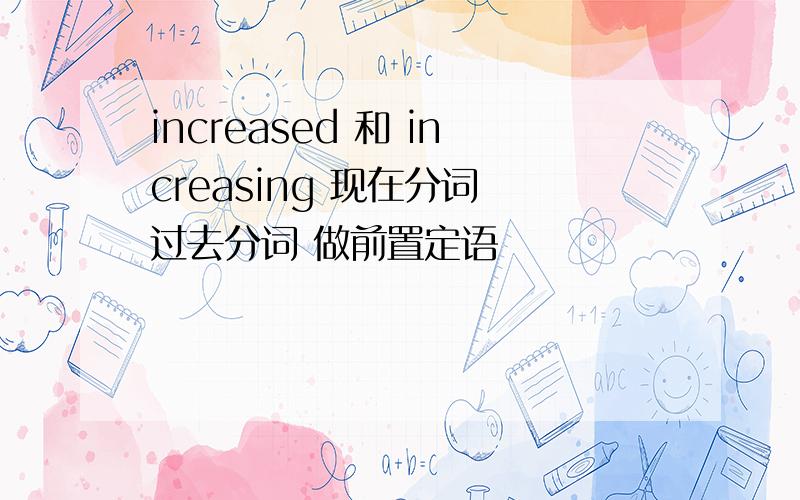increased 和 increasing 现在分词 过去分词 做前置定语
来源:学生作业帮 编辑:搜搜考试网作业帮 分类:英语作业 时间:2024/05/03 10:55:57
increased 和 increasing 现在分词 过去分词 做前置定语
现在分词在做前置定语的时候 表现出形容词的特性(动词特性完全消失),表”令人感到.的”或”即将/正在.的”
I visited a retiring teacher yesterday.昨天我去拜访了一个即将退休的老师.
This is a interesting book.这是一本令人有兴趣的书.
过去分词在做前置定语的时候 表现出形容词的特性(动词特性完全消失),
表”自我感到.的”或”已经.的”或”被...的”
I visited a retired teacher yesterday.昨天我去拜访了一个已经退休的老师.
I am interested in this book.我对这本书很有兴趣.
以上的都没有问题 很合理
但是到了The attorney general called for increased co-operation with private companies.(voa special English) 这句话中 increased co-operation with private companies.肯定做的是介词for的宾语.with private companies介词短语做的是co-operation的后置定语.这些都没有问题
要是把increased解读成co-operation的前置定语"已经增长过的" 总觉得很别扭.但是如果解释成动词"增加" ,这个句子翻译起来就很顺畅...
“司法部长呼吁要增加与私人公司的合作”
所以在这里求一下更好的解释...
在英语语法中 我知道有些句子中如果有动名词的话 可以适当把动名词解读成动词来理解 来翻译 会使句子顺畅很多,但是过去分词做前置定语 还第一次碰到这种情况.
难道理解成前置定语"被...的"?"司法部长呼吁与私人公司合作,并且这样的合作应被增加." 如果这样解读的话,会顺畅很多...很且没有违背语法原则.
现在分词在做前置定语的时候 表现出形容词的特性(动词特性完全消失),表”令人感到.的”或”即将/正在.的”
I visited a retiring teacher yesterday.昨天我去拜访了一个即将退休的老师.
This is a interesting book.这是一本令人有兴趣的书.
过去分词在做前置定语的时候 表现出形容词的特性(动词特性完全消失),
表”自我感到.的”或”已经.的”或”被...的”
I visited a retired teacher yesterday.昨天我去拜访了一个已经退休的老师.
I am interested in this book.我对这本书很有兴趣.
以上的都没有问题 很合理
但是到了The attorney general called for increased co-operation with private companies.(voa special English) 这句话中 increased co-operation with private companies.肯定做的是介词for的宾语.with private companies介词短语做的是co-operation的后置定语.这些都没有问题
要是把increased解读成co-operation的前置定语"已经增长过的" 总觉得很别扭.但是如果解释成动词"增加" ,这个句子翻译起来就很顺畅...
“司法部长呼吁要增加与私人公司的合作”
所以在这里求一下更好的解释...
在英语语法中 我知道有些句子中如果有动名词的话 可以适当把动名词解读成动词来理解 来翻译 会使句子顺畅很多,但是过去分词做前置定语 还第一次碰到这种情况.
难道理解成前置定语"被...的"?"司法部长呼吁与私人公司合作,并且这样的合作应被增加." 如果这样解读的话,会顺畅很多...很且没有违背语法原则.

是的,分词短语作定语时,过去分词表示被动,译成“被...的”或“经过了.的”,现在分词表示主动,直接译成“...的”翻译时要注意.
例句:
But, eventually, increasing power meant that even vw conceded the point and started to cool its motors with water.
但是,最终越来越强大的动力让大众汽车公司改弦更张,开始使用水冷方式冷却发动机.
Supporters, on the other hand, contend that the advantages-i.e. improved flood control, increased power generationcapacity and desirable impact on economic development in related areas-will far outweigh the disadvantages.
另一方面,支持者认为它的好处,例如经过了提高的对洪水控制的改善、发电能力和对相关地区经济发展的影响将远远超过它坏处.
例句:
But, eventually, increasing power meant that even vw conceded the point and started to cool its motors with water.
但是,最终越来越强大的动力让大众汽车公司改弦更张,开始使用水冷方式冷却发动机.
Supporters, on the other hand, contend that the advantages-i.e. improved flood control, increased power generationcapacity and desirable impact on economic development in related areas-will far outweigh the disadvantages.
另一方面,支持者认为它的好处,例如经过了提高的对洪水控制的改善、发电能力和对相关地区经济发展的影响将远远超过它坏处.